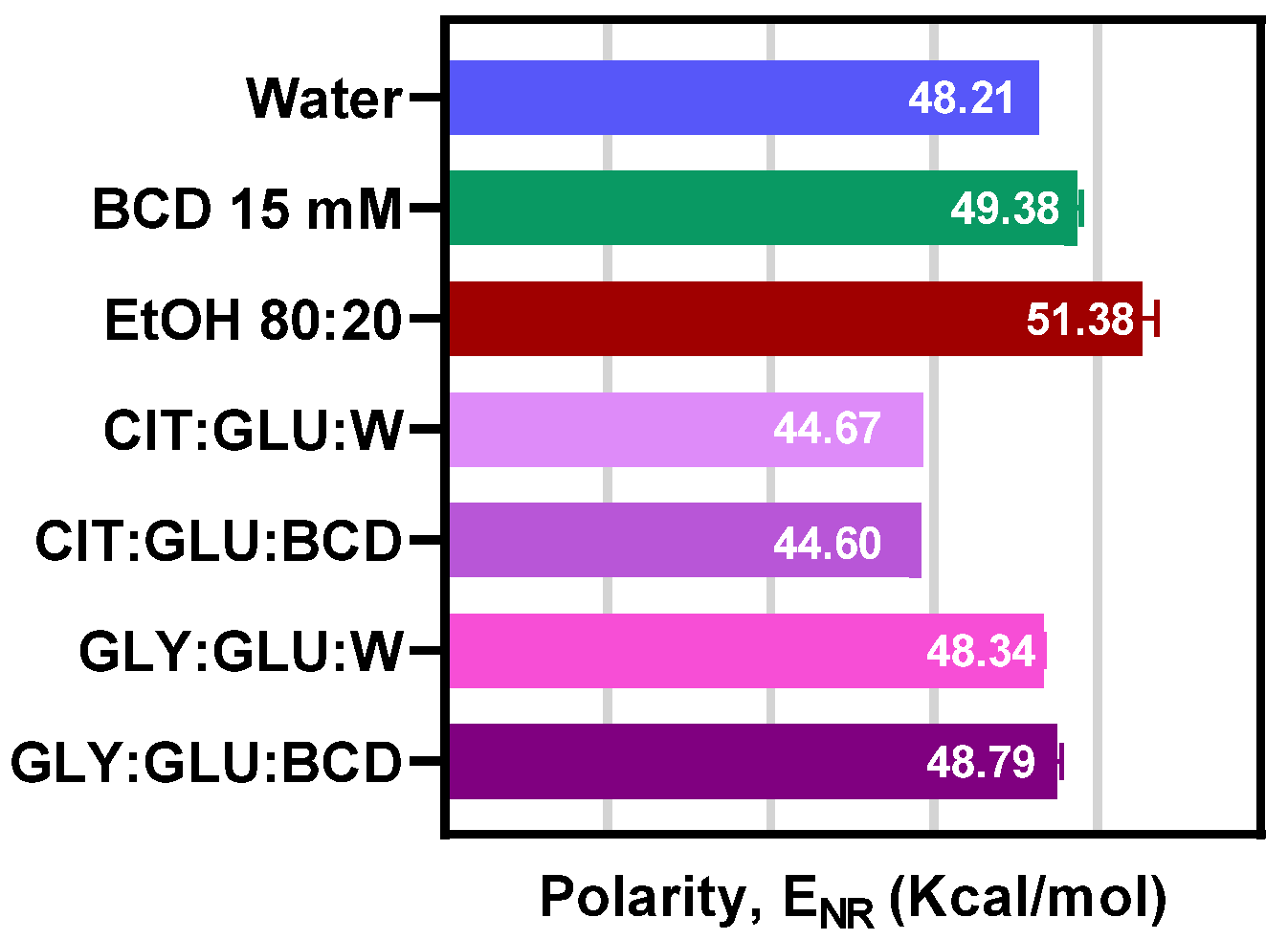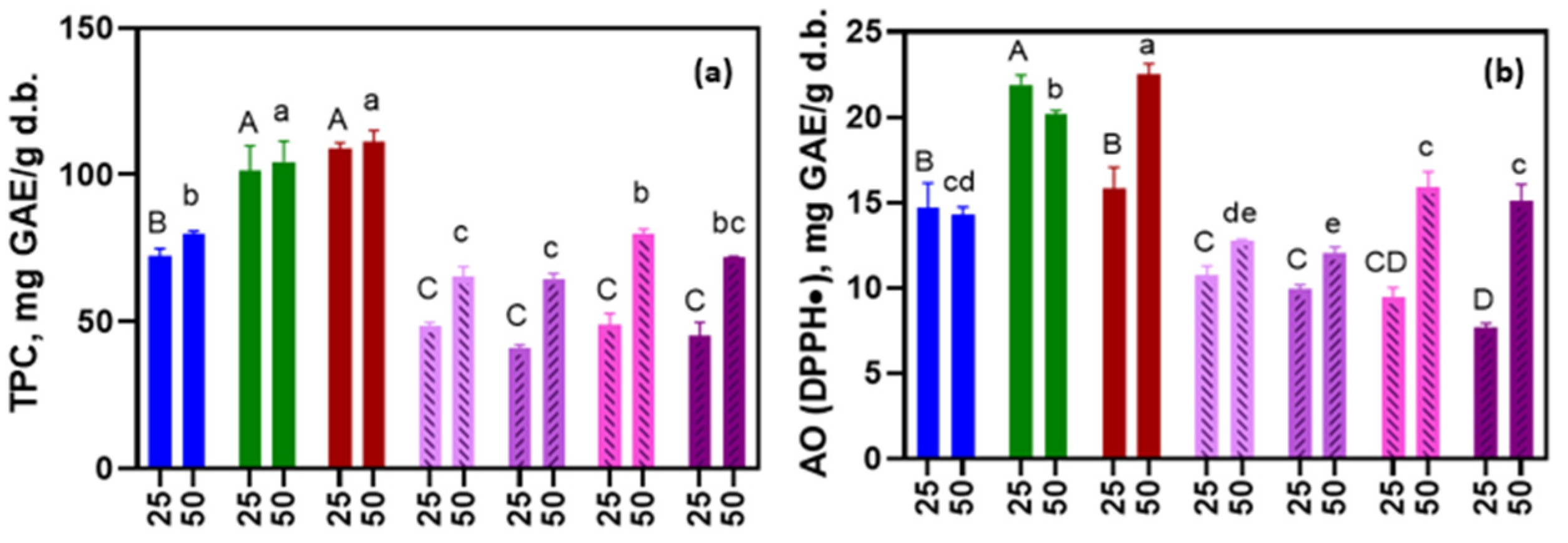Cyclodextrin-Based Natural Deep Eutectic Solvents: Physicochemical Characterization and Application for Green Extraction of Polyphenols from Moringa oleifera Leaves †
Abstract
1. Introduction
2. Materials and Methods
2.1. Materials and Chemical Reagents
2.2. NADES Preparation
- NADESs with citric acid (Cit), anhydrous glucose (Glu), and bidistilled water (W) were mixed in a molar ratio of 1:1:6.5 (Cit:Glu:W), according to Bergua et al. (2021) [11]. This system was also prepared with a 15 mM β-cyclodextrin (BCD) aqueous solution (Cit:Glu:BCD). Water or BCD solution was added to reach a final water content of 30% w/v. The systems were stored at room temperature.
- NADESs with glycerol (Gly) and anhydrous glucose were mixed in a molar ratio of 4:1, according to Jesús et al. (2021) [18]. Subsequently, bidistilled water (Gly:Glu:W) or 15 mM BCD aqueous solution (Gly:Glu:BCD) was added until reaching a final 30% w/v of water content. The systems were stored at room temperature.
2.3. NADES Properties Evaluated
2.3.1. Physicochemical Properties
2.3.2. Thermal and Rheological Properties
2.3.3. Use of NADES in Antioxidant Compound Extraction from M. oleifera Leaves
3. Results and Discussion
3.1. NADES Characterization
3.2. Application of NADES for Extraction of Antioxidant Compounds from M. oleifera
4. Conclusions
Author Contributions
Funding
Institutional Review Board Statement
Informed Consent Statement
Data Availability Statement
Conflicts of Interest
References
- Pagano, I.; Campone, L.; Celano, R.; Piccinelli, A.L.; Rastrelli, L. Green non-conventional techniques for the extraction of polyphenols from agricultural food by-products: A review. J. Chromatogr. A 2021, 1651, 462295. [Google Scholar] [CrossRef] [PubMed]
- Cannavacciuolo, C.; Pagliari, S.; Frigerio, J.; Giustra, C.M.; Labra, M.; Campone, L. Natural Deep Eutectic Solvents (NADESs) Combined with Sustainable Extraction Techniques: A Review of the Green Chemistry Approach in Food Analysis. Foods 2023, 12, 56. [Google Scholar] [CrossRef]
- Panja, P. Green extraction methods of food polyphenols from vegetable materials. Curr. Opin. Food Sci. 2018, 23, 173–182. [Google Scholar] [CrossRef]
- Anwar, F.; Latif, S.; Ashraf, M.; Gilani, A.H. Moringa oleifera: A food plant with multiple medicinal uses. Phytother. Res. 2007, 21, 17–25. [Google Scholar] [CrossRef]
- Prabakaran, M.; Kim, S.; Sasireka, A.; Chandrasekaran, M.; Chung, I. Polyphenol composition and antimicrobial activity of various solvent extracts from different plant parts of Moringa oleifera. Food Biosci. 2018, 26, 23–29. [Google Scholar] [CrossRef]
- Rocchetti, G.; Pagnossa, J.P.; Blasi, F.; Cossignani, L.; Hilsdorf Piccoli, R.; Zengin, G.; Montesano, D.; Cocconcelli, P.S.; Lucini, L. Phenolic profiling and in vitro bioactivity of Moringa oleifera leaves as affected by different extraction solvents. Food Res. Int. 2020, 127, 108712. [Google Scholar] [CrossRef]
- Dai, Y.; Van Spronsen, J.; Witkamp, G.; Verpoorte, R.; Choi, Y.H. Natural deep eutectic solvents as new potential media for green technology. Anal. Chim. Acta 2013, 766, 61–68. [Google Scholar] [CrossRef]
- Dai, Y.; Witkamp, G.; Verpoorte, R.; Choi, Y.H. Tailoring properties of natural deep eutectic solvents with water to facilitate their applications. Food Chem. 2015, 187, 14–19. [Google Scholar] [CrossRef]
- Ruesgas-Ramón, M.; Figueroa-espinoza, M.C.; Durand, E. Application of Deep Eutectic Solvents (DES) for Phenolic Compounds Extraction: Overview, Challenges, and Opportunities. J. Agric. Food Chem. 2017, 65, 3591–3601. [Google Scholar] [CrossRef]
- Mišan, A.; Nađpal, J.; Stupar, A.; Pojić, M.; Mandić, A.; Verpoorte, R.; Choi, Y.H. The perspectives of natural deep eutectic solvents in agri-food sector. Crit. Rev. Food Sci. Nutr. 2019, 60, 2564–2592. [Google Scholar] [CrossRef]
- Bergua, F.; Delso, I.; Muñoz-Embid, J.; Lafuente, C.; Artal, M. Structure and properties of two glucose-based deep eutectic systems. Food Chem. 2021, 336, 127717. [Google Scholar] [CrossRef] [PubMed]
- Makris, D.P.; Lalas, S. Glycerol and Glycerol-Based Deep Eutectic Mixtures as Emerging Green Solvents for Polyphenol Extraction: The Evidence So Far. Molecules 2020, 25, 5842. [Google Scholar] [CrossRef] [PubMed]
- Dos Santos, C.; Buera, P.; Mazzobre, F. Novel trends in cyclodextrins encapsulation. Applications in food science. Curr. Opin. Food Sci. 2017, 16, 106–113. [Google Scholar] [CrossRef]
- Matencio, A.; Navarro-Orcajada, S.; García-Carmona, F.; López-Nicolás, J.M. Applications of cyclodextrins in food science. A review. Trends Food Sci. Technol. 2020, 104, 132–143. [Google Scholar] [CrossRef]
- Dugoni, G.; Di Pietro, M.E.; Ferro, M.; Castiglione, F.; Ruellan, S.; Moufawad, T.; Moura, L.; Costa Gomes, M.F.; Fourmentin, S.; Mele, A. Effect of Water on Deep Eutectic Solvent/β-Cyclodextrin Systems. ACS Sustain. Chem. Eng. 2019, 7, 7277–7285. [Google Scholar] [CrossRef]
- Balenzano, G.; Racaniello, G.F.; Arduino, I.; Lopedota, A.A.; Lopalco, A.; Laquintana, V.; Denora, N. Cyclodextrin-based supramolecular deep eutectic solvent (CycloDES): A vehicle for the delivery of poorly soluble drugs. Int. J. Pharm. 2023, 647, 123553. [Google Scholar] [CrossRef]
- El Achkar, T.; Greige-Gerges, H.; Fourmentin, S. Basics and properties of deep eutectic solvents: A review. Environ. Chem. Lett. 2021, 19, 3397–3408. [Google Scholar] [CrossRef]
- Jesus, A.R.; Meneses, L.; Duarte, A.R.C.; Paiva, A. Natural deep eutectic systems, an emerging class of cryoprotectant agents. Cryobiology 2021, 101, 95–104. [Google Scholar] [CrossRef]
- Farooq, M.Q.; Abbasi, N.M.; Anderson, J.L. Deep eutectic solvents in separations: Methods of preparation, polarity, and applications in extractions and capillary electrochromatography. J. Chromatogr. A 2020, 1633, 461613. [Google Scholar] [CrossRef]
- Craveiro, R.; Aroso, I.; Flammia, V.; Carvalho, T.; Viciosa, M.; Dionísio, M.; Barreiros, S.; Reis, R.; Duarte, A.; Paiva, A. Properties and thermal behavior of natural deep eutectic solvents. J. Mol. Liq. 2016, 215, 534–540. [Google Scholar] [CrossRef]
- Singleton, V.L.; Orthofer, R.; Lamuela-Raventos, R.M. Analysis of Total Phenols and Other Oxidation Substrates and Antioxidants by Means of Folin-Ciocalteu Reagent. Methods Enzymol. 1999, 299, 152–178. [Google Scholar]
- Chaillou, L.; Nazareno, M. New Method to Determine Antioxidant Activity of Polyphenols. J. Agric. Food Chem. 2006, 54, 8397–8402. [Google Scholar] [CrossRef] [PubMed]
- Kovács, A.; Neyts, E.C.; Cornet, I.; Wijnants, M.; Billen, P. Modeling the Physicochemical Properties of Natural Deep Eutectic Solvents. ChemSusChem 2020, 13, 3789–3804. [Google Scholar] [CrossRef] [PubMed]
- Joules, A.; Burrows, T.I.; Dosa, P.; Hubel, A. Characterization of eutectic mixtures of sugars and sugar-alcohols for cryopreservation. J. Mol. Liq. 2023, 371, 120937. [Google Scholar] [CrossRef]
- Makoś-Chełstowska, P.; Słupek, E.; Fourmentin, S.; Gębicki, J. Supramolecular deep eutectic solvents in extraction processes: A review. Environ. Chem. Lett. 2024, 23, 41–65. [Google Scholar] [CrossRef]
- Benvenutti, L.; Zielinski, A.A.F.; Ferreira, S.R.S. Which is the best food emerging solvent: IL, DES or NADES? Trends Food Sci. Technol. 2019, 90, 133–146. [Google Scholar] [CrossRef]
- Maraulo, G.E.; Santos Ferreira, C.; Mazzobre, M.F. β-cyclodextrin enhanced ultrasound-assisted extraction as a green method to recover olive pomace bioactive compounds. J. Food Process. Preserv. 2021, 45, e15194. [Google Scholar] [CrossRef]
- Ratnasooriya, C.C.; Rupasinghe, H.P.V. Extraction of phenolic compounds from grapes and their pomace using β-cyclodextrin. Food Chem. 2012, 134, 625–631. [Google Scholar] [CrossRef]

 water,
water,  15 mM BCD solution,
15 mM BCD solution,  ethanol/water 80:20,
ethanol/water 80:20,  citric acid/glucose/water,
citric acid/glucose/water,  citric acid/glucose/BCD,
citric acid/glucose/BCD,  glycerol/glucose/water, and
glycerol/glucose/water, and  glycerol/glucose/BCD. Different uppercase and lowercase letters represent significant differences between samples at 25 °C and at 50 °C, respectively, with p < 0.05 using one-way ANOVA.
glycerol/glucose/BCD. Different uppercase and lowercase letters represent significant differences between samples at 25 °C and at 50 °C, respectively, with p < 0.05 using one-way ANOVA.
 water,
water,  15 mM BCD solution,
15 mM BCD solution,  ethanol/water 80:20,
ethanol/water 80:20,  citric acid/glucose/water,
citric acid/glucose/water,  citric acid/glucose/BCD,
citric acid/glucose/BCD,  glycerol/glucose/water, and
glycerol/glucose/water, and  glycerol/glucose/BCD. Different uppercase and lowercase letters represent significant differences between samples at 25 °C and at 50 °C, respectively, with p < 0.05 using one-way ANOVA.
glycerol/glucose/BCD. Different uppercase and lowercase letters represent significant differences between samples at 25 °C and at 50 °C, respectively, with p < 0.05 using one-way ANOVA.
| Cit:Glu:W | Cit:Glu:BCD | Gly:Glu:W | Gly:Glu:BCD | |
|---|---|---|---|---|
| Molar ratio | 1:1:9 | 1:1:9 | 4:1:13 | 4:1:13 |
| ρ (g/mL) | 1.35 ± 0.00 a | 1.38 ± 0.03 a | 1.25 ± 0.01 b | 1.24 ± 0.01 b |
| nD | 1.45 ± 0.00 a | 1.46 ± 0.00 a | 1.42 ± 0.03 a | 1.44 ± 0.00 a |
| aw | 0.761 ± 0.000 a | 0.746 ± 0.000 b | 0.672 ± 0.000 c | 0.661 ± 0.000 d |
| pH | 0.68 ± 0.01 d | 0.77 ± 0.02 c | 3.14± 0.01 b | 3.51 ± 0.01 a |
| σ (mS/cm) | 0.312 ± 0.000 a | 0.261 ± 0.000 b | 0.001 ± 0.000 c | 0.001 ± 0.000 c |
| Tg (°C) | −74.87 b | −73.60 b | −102.52 a | −102.90 a |
| ηapp | 125 ± 5 b | 175 ± 1 a | 37 ± 0 c | 33 ± 0 c |
Disclaimer/Publisher’s Note: The statements, opinions and data contained in all publications are solely those of the individual author(s) and contributor(s) and not of MDPI and/or the editor(s). MDPI and/or the editor(s) disclaim responsibility for any injury to people or property resulting from any ideas, methods, instructions or products referred to in the content. |
© 2025 by the authors. Licensee MDPI, Basel, Switzerland. This article is an open access article distributed under the terms and conditions of the Creative Commons Attribution (CC BY) license (https://creativecommons.org/licenses/by/4.0/).
Share and Cite
Lionello, M.E.; dos Santos Ferreira, C.I.; Mazzobre, M.F. Cyclodextrin-Based Natural Deep Eutectic Solvents: Physicochemical Characterization and Application for Green Extraction of Polyphenols from Moringa oleifera Leaves. Biol. Life Sci. Forum 2024, 40, 53. https://doi.org/10.3390/blsf2024040053
Lionello ME, dos Santos Ferreira CI, Mazzobre MF. Cyclodextrin-Based Natural Deep Eutectic Solvents: Physicochemical Characterization and Application for Green Extraction of Polyphenols from Moringa oleifera Leaves. Biology and Life Sciences Forum. 2024; 40(1):53. https://doi.org/10.3390/blsf2024040053
Chicago/Turabian StyleLionello, Melina Elizabeth, Cristina Isabel dos Santos Ferreira, and María Florencia Mazzobre. 2024. "Cyclodextrin-Based Natural Deep Eutectic Solvents: Physicochemical Characterization and Application for Green Extraction of Polyphenols from Moringa oleifera Leaves" Biology and Life Sciences Forum 40, no. 1: 53. https://doi.org/10.3390/blsf2024040053
APA StyleLionello, M. E., dos Santos Ferreira, C. I., & Mazzobre, M. F. (2024). Cyclodextrin-Based Natural Deep Eutectic Solvents: Physicochemical Characterization and Application for Green Extraction of Polyphenols from Moringa oleifera Leaves. Biology and Life Sciences Forum, 40(1), 53. https://doi.org/10.3390/blsf2024040053







